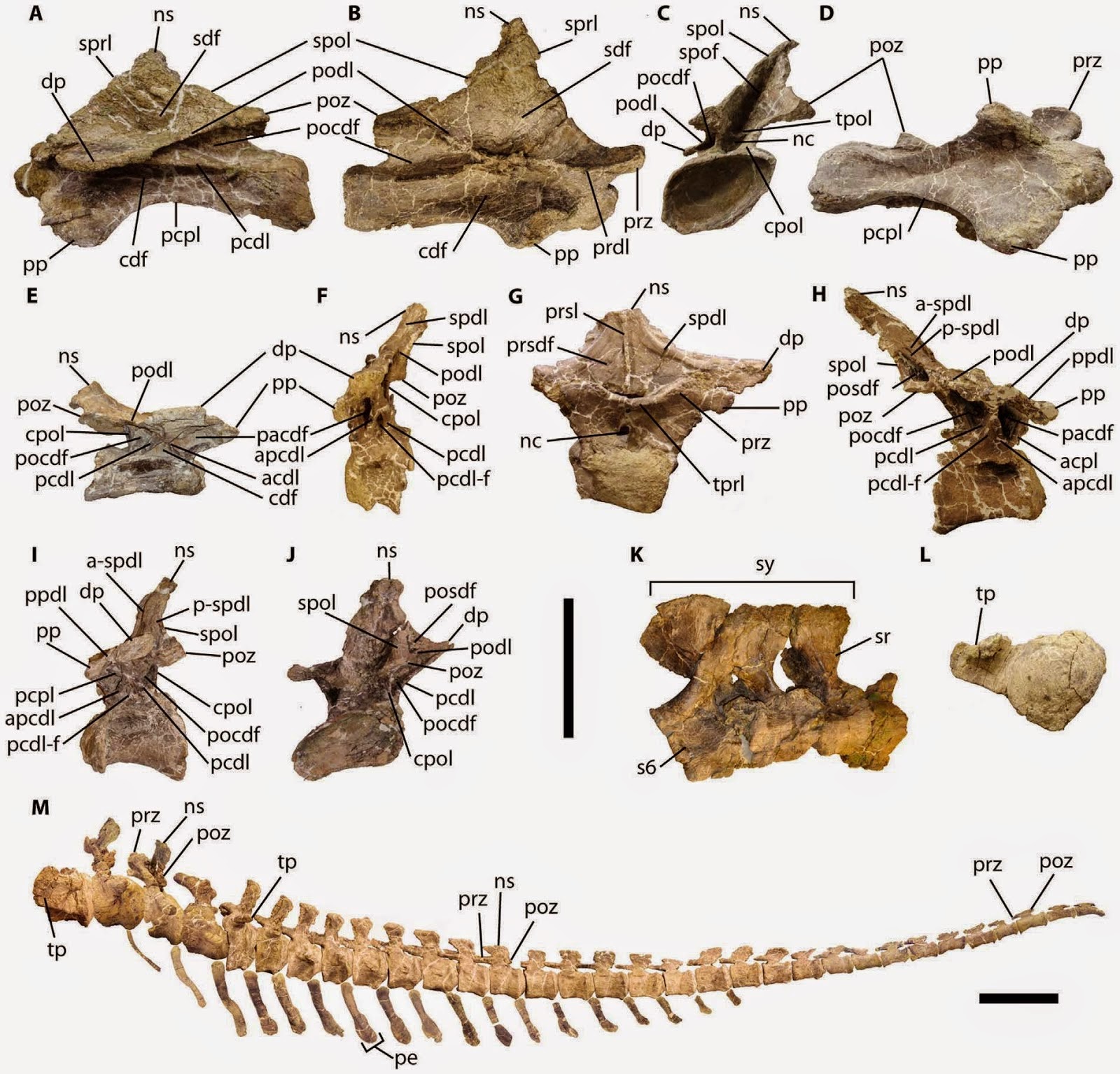Titanosaurs were the dominant group of Sauropod Dinosaurs throughout
the Cretaceous, becoming more numerous and diverse as the period went on as the
earlier Diplodocids became declined and became rarer. Despite the apparent
global success of the group, only four species have previously been described
from Africa, two each from Malawi
and Egypt.
In a paper published in the Journal of Vertebrate Paleontology on 9
September 2014, Eric Gorscak of the Department of Biological Sciences and Ohio Center for Ecology and Evolutionary Studies at Ohio University, PatrickO'Connor and Nancy Stevens of the Ohio Center for Ecology and Evolutionary
Studies and Department of Biomedical Sciences at the Ohio University HeritageCollege of Osteopathic Medicine and Eric Roberts of the School of Earth andEnvironmental Sciences at James Cook University describe a new species of
Titanosaur from the Middle Cretaceous Galula Formation in the Rukwa Rift Basin
of southwestern Tanzania. The Galula Formation is thought to represent a broad
floodplain with a meandering river which was laid down between 100 and 110
million years ago.
The new Dinosaur is named Rukwatitan
bisepultus, where ‘Rukwa’ refers both to the Rukwa Rift Basin and Lake
Rukwa, which is close to the site where the specimen was found, and ‘titan’
refers to the titans of Greek mythology, strictly the children of Uranus but
more generally anything large or brutish, while ‘bisepultus’ means ‘twice-burried’, a reference to the way in which
the specimen was preserved; first buried within a channel of a river, then
partially exposed by a new channel, then reburied. This is fairly typical
within the Galula Formation, where most fossils are found as individual bones,
disarticulated and scattered by the action of the river.
Quarry map (A) of the locality where the specimen was
found and rose diagram (B) to indicate predominant paleocurrent orientations of
elements in different facies; (C) photograph of in situ skeletal elements of Rukwatitan bisepultus in the quarry wall
at the locality to illustrate the distinction between overbank and channel
facies (see white hashed line); (D) middle caudal vertebra of
Rukwatitanbisepultus in left lateral view illustrating matching contact areas
of a single bone that was partially eroded (in the deep past), mobilised over a
very short distance (approximately 1.5 m), and redeposited as part of a channel
facies. Abbreviations: H, left humerus, proximal portion; H’, left humerus,
distal portion; IL, leftilium; SC, left scapular blade; VR, vertebral rib. Scale
bar in (D) equals 5 cm. Gorscak et al. (2014).
The new species is described from a partial skeleton comprising
numerous partial and intact vertebrae, several ribs, part of the left scapula,
parts of both coracoids, the left humerus and ilium, and parts of the right
ulna and pubis.
Silhouette reconstruction of Rukwatitan bisepultus to
illustrate those portions of the skeleton recovered. Scale bar equals 1 m. Gorscak et al. (2014).
See also…
Titanosaurs were a group of Sauropod Dinosaurs that became the
predominant large herbivores during the last 30 million years of the
Cretaceous. They were a diverse group, and included several truly
gigantic species, which are thought to have been the largest...
 A new species of Titanosaur from the Late Cretaceous of northwestern Madagascar. Titanosaurs were the dominant group of Sauropod Dinosaurs in many Late
Cretaceous faunas. The group included the very largest Sauropods, and
therefore also the very largest known land animals of any type.
Titanosaur remains were first found in Madagascar in the 1890s, though
the first species from Madagascar, Rapetosaurus krausei, was not
formally described until...
A new species of Titanosaur from the Late Cretaceous of northwestern Madagascar. Titanosaurs were the dominant group of Sauropod Dinosaurs in many Late
Cretaceous faunas. The group included the very largest Sauropods, and
therefore also the very largest known land animals of any type.
Titanosaur remains were first found in Madagascar in the 1890s, though
the first species from Madagascar, Rapetosaurus krausei, was not
formally described until... A new species of Titanosaur from the Early Cretaceous of northern Texas. Sauropod dinosaurs were massive, long-necked, long-tailed creatures that
have long been regarded as the largest land animals ever to have lived.
They reached their most diverse in the Late Jurassic, with...
A new species of Titanosaur from the Early Cretaceous of northern Texas. Sauropod dinosaurs were massive, long-necked, long-tailed creatures that
have long been regarded as the largest land animals ever to have lived.
They reached their most diverse in the Late Jurassic, with...
Follow Sciency Thoughts on Facebook.



